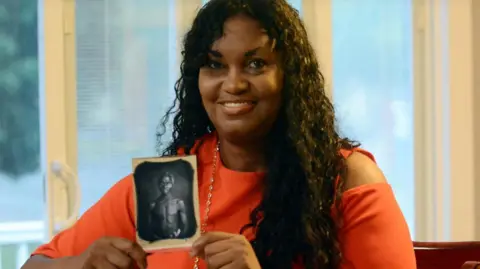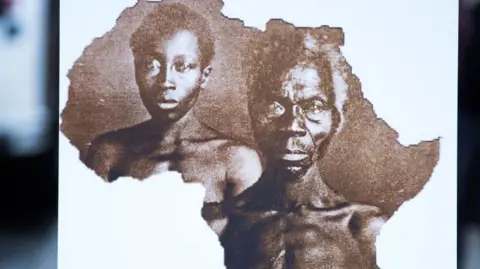Harvard agrees to switch photographs of enslaved individuals to black historical past museum
BBC Information
 Reuters
ReutersHarvard College has agreed handy over a set of historic photographs believed to be among the many earliest depicting enslaved individuals in the US.
The settlement ends an extended authorized battle between the establishment and Tamara Lanier, an creator from Connecticut who argues she is a descendant of two individuals proven within the photographs.
The pictures, taken in 1850, might be transferred to the Worldwide African American Museum in South Carolina, the place the individuals proven within the photographs have been enslaved.
Harvard mentioned it had all the time hoped the photographs can be given to a different museum. Ms Lanier mentioned she was “ecstatic” with the outcome.
The pictures are daguerreotypes, a really early type of modern-day pictures and have been taken 15 years earlier than the thirteenth Modification to the US Structure abolished slavery.
The photographs have been rediscovered in storage at Harvard’s Peabody Museum of Archaeology and Ethnology in 1976.
The 15 photos function individuals recognized by the Peabody Museum as Alfred, Delia, Drana, Fassena, Jack, Jem, and Renty. In response to Ms Lanier, the settlement would imply the switch of all the pictures not simply those about Renty and Delia.
The photographs have been commissioned by Harvard professor and zoologist Louis Agassizm as a part of discredited analysis to show the prevalence of white individuals. He espoused polygenism, a now debunked perception that human races advanced individually.
The case fashioned a part of public debate round how America’s universities ought to reply to their historic hyperlinks to slavery. In 2016, Harvard Legislation Faculty agreed to alter a defend that was based mostly on the crest of an 18th Century slaveholder.
Harvard didn’t touch upon the small print of the settlement however a college spokesperson mentioned it “has lengthy been keen to put the Zealy Daguerreotypes with one other museum or different public establishment to place them within the acceptable context and improve entry to them for all People.”
The spokesperson added that Ms Lanier’s “declare to possession of the daguerreotypes created a posh scenario, particularly as a result of Harvard has not been in a position to verify that Ms Lanier is said to the people within the daguerreotypes.”
 Getty Pictures
Getty PicturesMs Lanier sued Harvard in 2019, arguing the pictures have been taken with out consent and accusing the college of benefiting from them by means of massive licensing charges.
In 2022, the Massachusetts Supreme Judicial Courtroom upheld an earlier ruling that dismissed Ms Lanier’s declare to possession. She was, nonetheless, allowed to assert damages for emotional misery. It dominated Harvard had “complicity” within the “horrific actions” surrounding the creation of the pictures.
“Harvard’s current obligations can’t be divorced from its previous abuses,” it added.
Ms Lanier advised the BBC, she was “ecstatic” concerning the settlement. “I’ve all the time recognized initially that I may by no means take care of the daguerreotypes on the stage they might require,” she mentioned.
“There are such a lot of ties that bind Renty and Delia and the opposite enslaved individuals to that exact a part of South Carolina that to repatriate them there can be like a homecoming ceremony.”
The South Carolina museum helped Ms Lanier together with her family tree claims however was not concerned within the authorized battle. Its president mentioned they intend to carry and show the pictures “in context with reality and empathy.”
“These usually are not mild photos and the story behind how they got here to be is much more tough to listen to,” Tonya Matthews advised the BBC.
“So to be in an area that has already created room for conversations concerning the inhumanity of slavery and enslavement and the way far these implications echo even to at the moment is what we do and it is our mission.”


